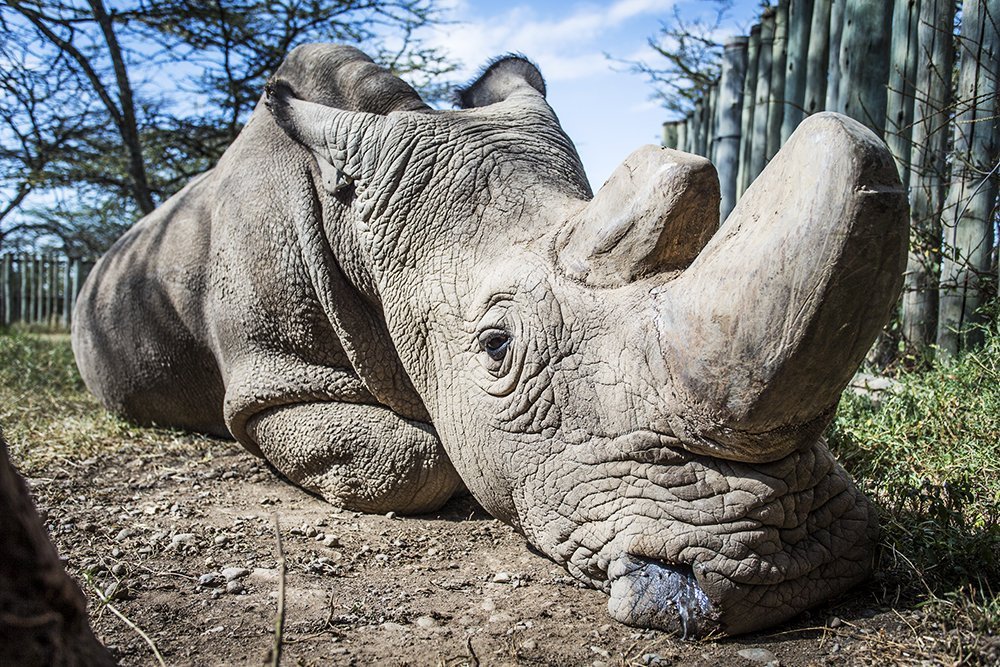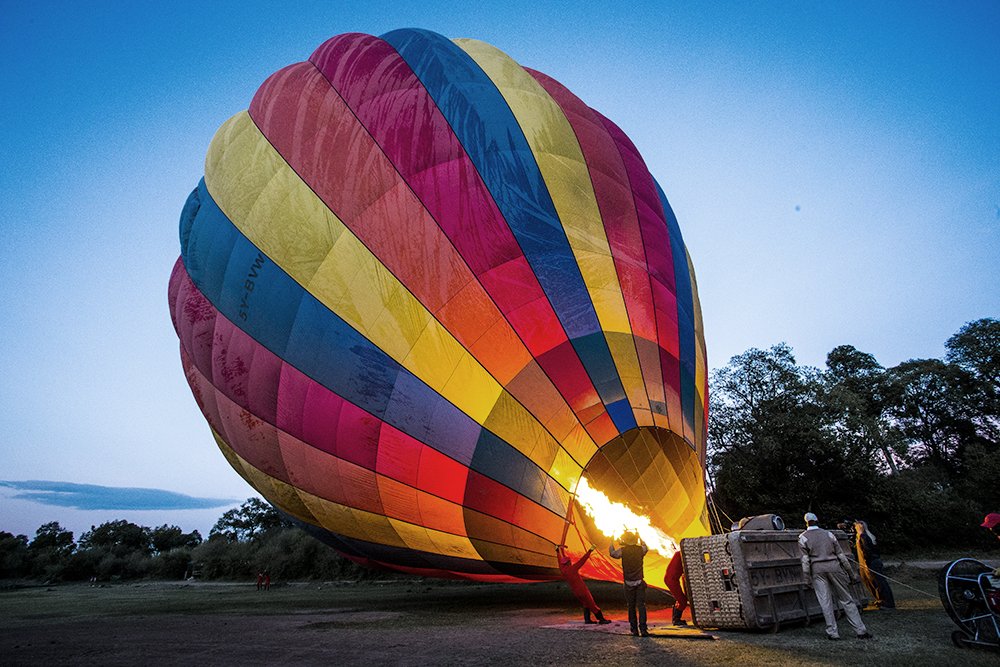Kenya calling

CURIOUS LITTLE TRUNKS grasp my hand to lead me along, while huge ears flap at my side. I’m surrounded by 24 orphaned baby elephants, who nudge me with their large heads. The childlike playfulness of these gigantic infants – ranging in age from three months to three years – hides the sad story of how they came to be at the David Sheldrick Wildlife Trust, just outside of Nairobi. Most had witnessed the deaths of their mothers, who were hunted and killed for the ivory trade or had died from starvation. The keepers here are devoted, sleeping beside the elephants each night to ensure the orphans receive the love and attention they need. Each individual bears the name of its homeland, and eventually will be released into the wild near the spot where it was originally found. Seeing how vulnerable these elephants are – and knowing that one day they too could be targeted for their tusks – helps me truly understand the need for effective conservation.
I AM IN KENYA, A PLACE I have dreamt of visiting my entire life. I grew up watching countless hours of David Attenborough documentaries, sitting on the edge of my seat enthralled as predators ruthlessly stalked their prey, preparing for the chase – and the inevitable kill. We are here to film the Australian Geographic Explores Kenya documentary and my aim is to see as much wildlife as possible; so far it has proven to be a magnificent country, where culture, nature and conservation collide on the grandest of scales.
After our encounter with the orphans, we pile into a safari vehicle and head out of Nairobi, bound for Ol Pejeta Conservancy in the foothills of snow-capped Mt Kenya. I am going to see something special: the last representatives of an entire subspecies. The northern white rhino is a subspecies of the white rhino, which once roamed through Uganda, Chad, South Sudan, the Central African Republic, and the Democratic Republic of Congo. Years of rampant and widespread poaching and civil wars have devastated their populations and they are now extinct in the wild.
Under armed guard I am escorted into an enclosure to meet Sudan, the world’s last male northern white rhino. He rests in the corner under the watchful gaze of his carers, who urge me to move towards him. He can hardly see from his left eye, so I approach slowly on his right. He sees me and allows me to get close. So close that I can stroke his dry, leathery skin and scratch behind his ear.
I feel honoured to meet Sudan. I look at his horns, just a mass of keratin like our fingernails, and feel sick that human desire for this has caused the annihilation of his entire kind.

‘Sudan’ (left) is the last remaining male northern white rhino on Earth. Only at the Ol Pejeta Conservancy is he safe under 24-hour armed guard. (Image Dean Miller)
DON’T LEAVE YOUR CAR. That’s the main rule when visiting Kenya’s wilderness areas and conservation parks. The threat of a lion attack is very real. But, at Lake Elementeita Serena Camp, 120km north-west of Nairobi, they have a novel approach to travel: horseback. Riders and mounts soon become one of the wild herd, so I hesitantly saddle up.
Once among the hundreds of zebra and buffalo, I am exhilarated. We plod alongside, no longer just spectators. We stop when they stop to graze, and we watch for predators as they must. Lions were spotted here just three days earlier, and we feel like prey, constantly scanning the horizon for movement, watching our hoofed friends and listening intently for a deadly footfall close by.
THERE ARE TWO WAYS to get to the famous Maasai Mara: you can take a 40-minute flight from Nairobi, or you can rough it out on a mixture of paved and dirt roads like everyone else. I believe you have to earn your passage to the Mara, so I hitch a ride by bus with a tour group.
As we slowly enter the Maasai Mara along a well-worn dirt road toward Mara Serena Safari Lodge, I look out the window at the vast yellow grasslands and see wildebeest. We aren’t even on safari yet and herds of about 50 elephants roam between the acacia trees, giraffes amble along with a slow and purposeful gait, hippos splash in the river, Thomson’s gazelles dart away from us and zebra break up the horizon with their distinctive stripes.
I want to stop and stare at everything, but first we must make a stop. High into the ridges we climb and I soon notice more familiar animals: cattle. They are also on the move in a small, tight herd being urged along by a tall man wrapped in red – a Maasai warrior.
The Maasai are semi-nomadic and live in small villages within an ‘enkang’, a large circular and impenetrable boundary made from acacia trees and other plant matter to keep livestock in at night – and predators out. They live right alongside some of the biggest conservation parks where animals are allowed to roam free.

Maasai women (above) are adorned in beautiful jewellery and clothing that bring colour and culture to the harsh landscape in which they live. (Image Dean Miller)
Once, predators such as lions were killed for male coming-of-age ceremonies or because they threatened livestock, but now, through conservation programs that aim to benefit both wildlife and the Maasai way of life, this practice is discouraged.
At the village, I’m taken into the enkang by the chief and his son, through a small thatched archway. As I enter into their world, I am overwhelmed by a sea of people chanting from the depths of their bellies, their bodies covered in bright garments and adorned in jewellery and beads. I’m uncomfortable, with all eyes fixed on me, but their smiles soon put me at ease.
The chief places a ‘shuka’ over my shoulders, a red robe for deterring lions, I am told. I am also given a traditional walking stick, a necklace and the chief’s own lion-mane headdress. His son explains that as a young man his father and other Maasai teenage boys were sent out to become men on the open plains of the Mara.
Killing a lion was the epitome of strength and courage. His father was brave enough to sneak up to the lion and be the first to throw a hand spear at it. Although I had mixed feelings about wearing a lion’s mane, I respected the skill needed to get near a lion armed with nothing but a sharpened stick.
AS LIGHT BREAKS OVER THE horizon, our hot-air balloon is ready for take-off. We float over the treetops and watch as the sun rises, its golden rays touching everything from the Mara River, in Kenya, right into the Serengeti in Tanzania. Silently sailing through the air, within 15 minutes I spot every major Kenyan animal I had ever wished to see. Hippos lounge in the waters of the Mara River and crocodiles drag themselves up its banks. Elephants stride across the open plains beside herds of giraffe, zebra, gazelle and wildebeest. Rhino rest in the shade of acacia trees and ostriches strut along, while warthogs kick up dust and hyena lollop off in their awkward way.
But it is the big cats that steal the show. A lone leopard silently stalks along the riverbank, cheetah amble through the long grass, and a pride of lions reclines under a clump of trees.
Thanks to our bird’s-eye view, we now know roughly where to find the animals, and it’s finally time to go on safari. The LandCruisers are designed for comfort, but their pop-top roofs also offer incredible views. I am astounded by the number of animals. I expected to see an elephant or two, but in two days I spot at least 20 herds of them. Zebra, gazelle, buffalo and wildebeest wander in their thousands; giraffe are often in pairs grazing just metres from us, while the rivers offer up hippos and crocodiles.

A pre-dawn inflation of a hot-air balloon. Possibly the best way to see the great open plains of the Maasai Mara – a trip here is simply not complete without a balloon flight. (Image Dean Miller)
The drivers are the eyes and ears of the Maasai Mara, and are busy on the radio in Swahili, exchanging the whereabouts of the harder-to-find animals. We come across two gorged cheetahs – they are uncomfortably full, rolling around in the grass in the shade of a tree. A call comes over the radio and the driver quickly starts the engine. “Lions?” I ask. He grins cheekily and drives on.
Not 1km away, we find four. Two females under one tree, and two males near another. Nothing can prepare you for seeing lions in the wild. Here on the open plains of the Maasai Mara – their natural habitat – they are king.
I AM A SCIENTIST, conservationist and nature lover, so my expectations for this trip were high. But Kenya delivered. From the diversity and abundance of wildlife to the wonderful people living alongside them, it offers an unforgettable adventure. For me, though, it was the endless plains speckled with animals, the acacia trees, and the flaming sunsets that starred; Kenya’s landscape truly stole my heart.
The essentials
Getting there: Many airlines fly to Kenya from most major Australian cities, so prices are competitive. Australians do require a travel visa to visit the country and must have an up-todate yellow fever vaccination.
Kenya Airways fly from Nairobi to Bangkok, Hong Kong and Guangzhou with connections on codeshare airline partners through to Australia.
Getting around: Wildlife Safari, the luxury travel company, presents the ultimate wildlife safari – the most exciting, value-for-money safari available today. It’s a nine day luxury Kenya safari visiting three unique and diverse wildlife sanctuaries.
When to travel: Kenya offers fantastic wildlife experiences year-round, however, the peak travel season is from July to November during the annual wildebeest migration.
Seasons
• Dry Season – December to March and June to October
• Long Rains – March to June
• Short Rains – November
People: Kenya boasts at least 40 different ethnic African groups. There are many different languages spoken, but Swahili, the national language alongside English, is the most widely spoken. It is a culturally diverse nation, with large populations of Europeans, Arabs, Indians and Pakistanis. Two-thirds of the population identify as Christian and about 15 per cent of Kenyans are Muslim, but belief systems among the remote tribes remain largely indigenous.
Points of Interest
1. Great Rift Valley
2. Lake Nakuru
3. Lake Victoria
4. Maasai Mara National Reserve
5. Crescent Island
6. Mount Kenya
7. Nairobi National Park
8. Tsavo East National Park
More Information
www.kenya-airways.com
READ MORE:
- Documentary trailer: Australian Geographic Explores Kenya
- Climbing Mt Kenya: Africa’s other big mountain






